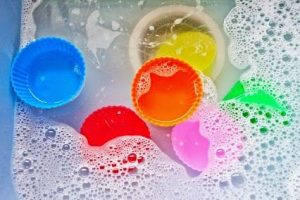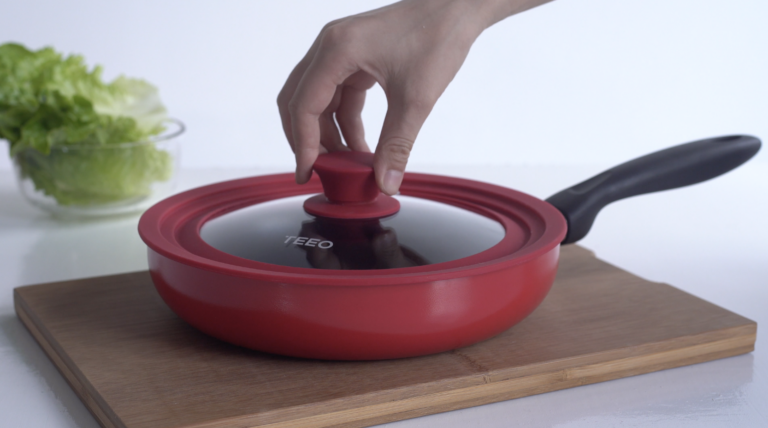How to Clean Silicone Bakeware
Everyone should know how to clean their silicone bakeware. It’s really easy, and some helpful tips will make cleaning your bakeware a breeze!
So grab yourself an oven mitt, and let’s get started!

How to clean silicone molds?
If you have silicone molds, you know that they can be a bit tricky to clean. But with these tips and tricks, you’ll be able to get them clean in no time!
First, you’ll want to use a silicone cleaner. These cleaners are easy to use and effective at cleaning everyday items and removing caulk and residue. You can find them at most hardware stores.
Next, you’ll want to sanitize your phone case. The best way to do this is with a vinegar solution. Mix 1 part vinegar with 3 parts water and apply it to the case with a cloth or sponge. Let it sit for 10 minutes before rinsing it off with water.
Finally, if you have any stubborn stains on your silicone molds, you can try scrubbing them with a toothbrush or soft-bristled brush. Just be sure not to use anything too abrasive, as this could damage the mold.
Can silicone go in the dishwasher?
If you find yourself asking can silicone go in the dishwasher? Yes, silicone is dishwasher-safe. Silicone can be put in the dishwasher because it does not react with any detergent or water and does not corrode as metals do.
How do you take care of silicone molds?
Silicone molds are very easy to take care of and can be washed with soap and water or dish detergent. The best way to avoid the bubbles is by using a damp cloth to wipe away any excess release agent.
If you want to keep your silicone and wood molds in great condition for years to come, you must take care of them properly. Here are some tips on how to clean silicone bakeware:
What makes a proper cleaning for silicone?
Silicone bakeware is a popular choice because it is nonstick and versatile. However, like all bakeware, it needs to be cleaned properly to maintain its performance and longevity. There are a variety of silicone cleaners on the market, but most can be easily cleaned with just soap and water.
There are many recipes for silicone cleaners, but some work better than others. For example, vinegar and water solution can be used to clean molds or to sanitize phones. As long as the silicone is non-toxic, most solutions will work.
Can you use heat when cleaning silicone molds?
You can use the oven to speed up the removal of sticky silicone. The oven should be heated to 350 degrees F (177 degrees C). Place the silicone pieces in the oven for 10 minutes.
How can you clean black mold off of silicone?
If you have black mold on your silicone, you can clean it off with distilled white vinegar. Just spray the vinegar on the mold and wipe it away. Wear gloves when using vinegar or bleach to clean black mold. If vinegar or bleach is not working, you can try using bleach. But make sure you wear gloves and a face mask when using bleach.
What can you use to clean silicone?
Silicone cleaners are a great way to clean your silicone bakeware. They come in a variety of forms and can be used for a variety of purposes. There are many different silicone cleaners recipes to find the perfect one for your needs.
You can use various items to clean silicone bakeware, including vinegar, baking soda, and hydrogen peroxide. In addition, you can also use a recipe to sanitize your phone case or other silicone items. Using these tips and tricks, you can make cleaning your silicone bakeware a breeze!
Use dish soap and water
You can use dish soap and water to clean your silicone kitchenware, just like you would with any other type of cookware. However, rinse the soap well, as it can be difficult to remove if left on. You can also use a mild vinegar solution to clean your silicone.
Use vinegar and water
Spray the area with vinegar and water solution. Leave the solution on the silicone for a few hours. Then, wipe away the solution with a clean cloth.
Use rubbing alcohol
If you are in a pinch and do not have access to a specialty cleaner, rubbing alcohol is a good option. However, rubbing alcohol adds a level of danger that must be avoided. If you try to smoke with rubbing alcohol still present inside the pipe, it could easily start a fire or cause serious damage to your lungs!
Use baking soda and water
Baking soda is an effective and natural way to clean silicone. Just mix equal parts baking soda and water, and use a sponge to scrub the silicone. Rinse with hot water and soap afterward.

If you love to bake and are looking for ways to clean your silicone bakeware, these tips are for you! Buying silicone baking pans can be extremely expensive, so they must last a long time.
To keep them lasting forever, some hacks and tips will show how easy it is!
Using grease-cutting dish soap
In cleaning off silicone grease, you need to fill the sink with dish soap and water. First, stopper your kitchen sink and fill it with hot water – as hot as you can tolerate. Next, pour a few drops of anti-grease dish soap and mix it in so the water suds up. The grease-cutting dish soap is designed to tackle hard-to-clean stains like the ones famously acquired by silicone bakeware.
Make sure you use very hot water. Lukewarm or cold water will not effectively clean your silicone bakeware.
Soak the silicone bakeware in grease-cutting dish soap. Place the silicone bakeware in the hot, soapy water and let it soak. Leave the bakeware in the sink for at least thirty minutes, though you may need to leave it for a bit longer (one hour) for tough stains.[
While your preference might be to use more natural dish soap, those ingredients won’t be nearly as effective for the tough stains you’ll find on your silicone bakeware.
Scrub with a nonabrasive sponge. Apply some grease-cutting dish soap and scrub the silicone bakeware with a nonabrasive sponge. Get in there and scrub hard to remove the stains.[
You may have to spend a lot of time and energy getting rid of these stains.
Repeat the process. You may need to repeat the process several times to get the stains out. Getting some of these stains out of your silicone bakeware will take some real elbow grease. Try using the grease-cutting dish soap again and scrubbing it over and over.[
Try to use even hotter water the second time. For example, if you have rubber gloves, you’ll be able to use hotter water while cleaning silicone bakeware.
Rinse and dry the silicone bakeware. When you have finished scrubbing the stains on your silicone bakeware, you should rinse off any remaining soapy residue in the sink. Then place the bakeware on a towel or drying rack to let the water runoff.
Make sure you allow the silicone to dry completely before using it again. This usually takes at least an hour or two.
Removing tougher stains
Heat your silicone bakeware before cleaning. For extra tough greasy stains, it can be beneficial to heat your silicone bakeware in the oven before cleaning. Preheat your oven to 350 °F (177 °C). Once the oven is fully preheated, put the silicone bakeware into the oven for ten minutes. This will help heat the food stains stuck on the bakeware and make them easier to clean.[
After you’ve heated the bakeware, try washing it with grease-cutting dish soap and baking soda. Be careful not to burn yourself while handling the bakeware when you remove it from the oven.
Apply baking soda. Wet your silicone bakeware in the sink and shake all the water off. You want the item to be damp but not dripping wet. Next, identify where there are still greasy food stains and sprinkle some baking soda on each spot.
Be sure to give a generous sprinkling of the baking soda, not just a light dusting.
Make a paste out of the baking soda. Gently massage the baking soda with a damp cloth so that the water helps the baking soda powder form a thick paste. You want the baking soda paste to be applied heavily to each stain on your silicone bakeware.
Let the baking soda dry completely, which could take several hours.
Rinse and repeat. Once the baking soda is fully dried, rinse it in the sink with hot water. If the stains have not dissipated, try washing them with grease-cutting dish soap or apply the baking soda again.
You may have to repeat this process quite a few times to get your silicone bakeware perfectly cleaned.
Rinse and dry the bakeware. Once you have finished removing the baking soda paste, use some dish soap to wash the silicone. Then rinse all of the soap off in the kitchen sink. Next, you should place the silicone bakeware on a towel or a drying rack and let it fully dry before using the item again.
Be sure not to store your silicone bakeware in the cabinet while it is still wet, as this could lead to mold and bacteria forming on your kitchenware.
Taking preventative measures
Rinse immediately after use. One of the worst things you can do to silicone bakeware is to let the residue sit for long periods before cleaning. Instead, when you finish baking, you should rinse the silicone bakeware with grease-cutting dish soap. This will help maintain the integrity of your silicone bakeware and make future cleaning much easier.
At the very least, fill the silicone bakeware with water and dish soap immediately after use so you can go back and clean it later.
Avoid using abrasive sponges. Scrubbing silicone bakeware with abrasive sponges will not work more effectively in cleaning than a regular sponge or cloth. And it may even damage your silicone bakeware in the process.
Using an abrasive sponge can chip off pieces of the silicone and, over time, minimize the nonstick of the pan.
Forego the cooking sprays. Silicone bakeware is considered nonstick own right, so you don’t need to use nonstick sprays with this type of bakeware. Also, it will not help you get items out of the silicone pan any quicker than you would be able to with it.
Additionally, using cooking sprays with silicone bakeware will contribute to the sticky, greasy mess you have to clean up later and cause more damage to your pan over time.
- Proper Care for Your Kitchenware: How to Maintain Your Nonstick Pan - January 30, 2022
- Everything You Need to Know About Doing Your Dorm Laundry: Laundry bag or hamper? Which dorm laundry basket should you go for? - December 20, 2021
- Home Office Storage Cabinet: A complete guide to help you find the best one for your specific needs - July 12, 2021





